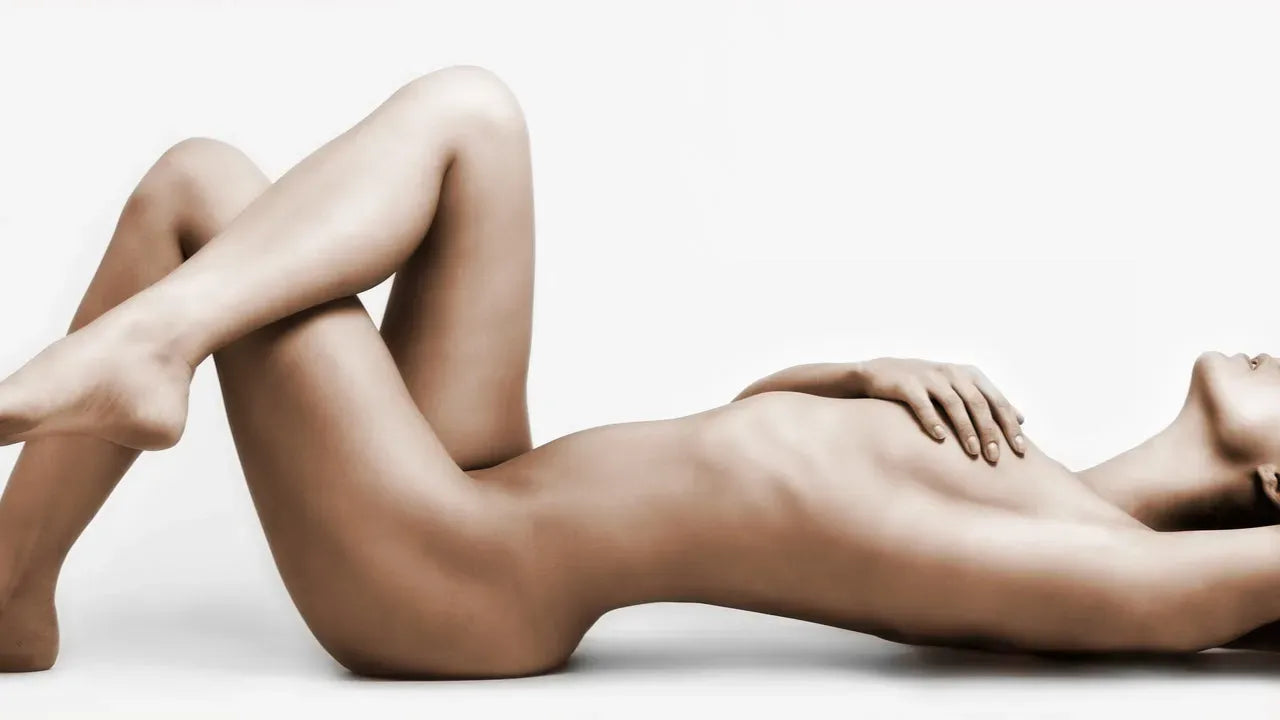
How we can master the art of female masturbation
This touchy subject has long been the stuff of men’s locker room talk, but it’s about time we ladies talked about it too.
It’s no secret that men masturbate a lot. So often, in fact, that in our modern culture it’s regarded as a normal (if not essential) part of masculinity itself. Many people simply accept masturbation as “the boys’ ritual”— a rite of passage in adolescence, and then a manifestation of male virility for decades to follow.
While we’re tolerant or even encouraging of guys jerking off, our society isn’t as considerate to women. From an early age, we girls are taught to keep our hands off the private parts. Touching ourselves for pleasure is quickly deemed unladylike.
If you’ve been on a dating app, you’ve probably seen at least one guy declare: “Girls shouldn’t get off themselves. That’s just a turn-off.”
Masturbation is already a touchy subject as it is, and it's bad enough that we think of it so much as a guy thing. We don't openly discuss it as females, even as evidence suggests that women masturbate just as much, if not more frequently, than men.
To spark a healthier and more open-minded conversation about this undeniable reality, we need to educate ourselves about it. Here’s all you need to know about female masturbation… and why you deserve to give yourself a helping hand too.
A nice, feminine touch
When you hear the word masturbation, the first image that probably comes to mind is that of a man messily relieving himself, hoping he wouldn’t get caught. After all, we’ve all had that encounter with that one guy who shamelessly trumpets his bawdy escapades led by his right (or left) hand.
Our own “me time,” on the other hand, remains carefully tucked away in layers of silence and wariness. Yet female masturbation is just as we’ve always done it in the dark. It’s how we stimulate our own genitals— stroking or rubbing our clitoris, inserting a finger or two up our vagina— until we reach orgasm.
You can also do this in various positions, like lying on your back or stomach, sitting, squatting, kneeling, or standing. When you're in the shower, you can even find it pleasurable to direct the water jets of your showerhead toward your vulva. Then there are women who enjoy straddling a pillow, some scrunched-up fabric, corners of furniture (not too sharp, we hope) against their own clothing.
A multitude of sex toys such as vibrators, dildos, and Kegel balls are available to assist women in masturbating. Not to mention, you can opt for lube to let your experience go much smoother.
According to The Kinsey Institute, more than half of female respondents aged 18-49 said that they masturbate at least once every 3 months, regardless of whether they’re single. But even as they’re open to the idea of self-pleasure, guilt still gets in the way: Women are hesitant to tell others that they do it at all.
Sweden coined klittra, a new local term for female masturbation, so women won't get ashamed of the male connotations of the word masturbation.
Evidently, masturbation is still dripping with a sticky undertone of being primal, carnal, and brutish. These are words that could only affirm a guy’s manhood but would sooner tear down a woman’s reputation.
No wonder admitting to masturbating still feels like getting caught with your hand in the cookie jar… just as you’ve convinced everyone that you’ve been religiously following your gluten-free diet.
Hand of history
Has female masturbation always been seen in a negative light? Not quite. While humanity has been more fixated on the male variety, even some early civilizations sang praises to women’s self-pleasure as an art form.
Here's a quick rubdown of how female masturbation throughout the centuries:
SET IN STONE
This story starts 30,000 years ago in Germany where somehow, there's at least one woman who thought that it'd feel great to pleasure herself with a shiny stone dildo. To date, it's the oldest sexy artifact that we've discovered yet. It would seem that female masturbation was already a thing of the past… if you get what we mean.
AS THE ROMANS DO
Women in ancient Greece also had a great grasp on their satisfaction. It was a common belief at the time that women should be able to orgasm just like men in order to get knocked up. That's why they were encouraged to pleasure themselves for the benefit of humanity.
In fact, there are even images of women masturbating, and these artifacts even showed just how the Greeks did it: buying leather or wooden dildos called olisbos.
The female Romans that came after them weren't shy about masturbation, either. In fact, archaeologists have uncovered erotica on the walls of Pompeii that show just how they enjoy their own company.
WILDEST DREAMS
Heading further down south, the Egyptians aren't the type to miss out on these pleasures. In fact, they even took it up a notch. You could say that they venerated masturbation so much since their god Atum created the entire world in a wank.
In true Egyptian fashion, Cleopatra followed suit as their sultry pharaoh. Even though she had many suitors, including the infamous Mark Antony, she also had her fair share of solo play. Legend has it that she created the first vibrator in written history by filling a gourd with bees.
You think that's wild? Wait till you hear how she had a thing for rattlesnakes... at least until she died from the bite of her own asp.
GOING HYSTERICAL
Although many people widely condemned the act of masturbation, experts of the Victorian Era believed that “hysterical paroxysm” (read: orgasm) was the only deterrent to a psychological illness that manifested itself in shortness of breath, insomnia, nervousness, and muscle spasms. In response, the doctors administered regular doses of “pelvic massages” to women so they wouldn’t succumb to their hysteria or pent-up sexual tension.
As they say, necessity is the mother of invention. Yet what gave birth to vibrators was how men thought they had better things to do than give their clients or partners pleasure. Masturbation was put in the hands of women once again, this time in the form hand-cranks brought by the 1890s.
STEAMY LOVE AFFAIR
When they tell you to “get a room,” they probably didn’t have the Manipulator in mind. As the world’s first steam-powered vibrator, this sex machine was literally built by the American doctor George Taylor to occupy your backroom. But this engine wasn’t packed with a lot of power just yet— it would take at least an hour to induce a hysterical paroxysm at all.
That was soon followed by a less bulky model, though it needed a 40-pound battery to take you to pound town in 5 minutes. Still, it wasn’t until the 1900s that girls started to take home their own vibes. Hamilton Beech made an electric-powered one in 1902 that was introduced as an essential household appliance.
The vibrator is the fifth household appliance that was manufactured en masse electrically, even before the vacuum cleaner was invented.
Unfortunately, this product didn’t last long in the market. This vibrator disappeared soon after the porn industry got ahold of it; women no longer wanted to associate themselves with its sexual overtones.
The perks of self-care
Fast forward to today, women are still not given enough space to recognize their own sexual wellbeing without any degradation. While some are starting to go ahead and explore, the act of masturbation still mostly comes in hand in hand with guilt.
But it’s not too late to view self-pleasure in a more positive light, especially with all the good things that come with it. Here are some of its benefits, to name a few:
- Masturbation helps you get in touch with yourself. It allows you to become more comfortable and confident and this can lead to better sexual experiences for both you and your partner.
- As if it isn’t obvious enough, it’s a good mood booster. Even when you don’t orgasm, it prompts the release of feel-good endorphins that not only help regulate emotional stress but also help with a good night’s sleep.
- It helps relieve pain and muscle cramps in lower regions. Because it also lubricates the vagina and flushes out harmful bacteria from the cervix, it’s a great deterrent to urinary tract infections. It even relieves post-menopausal symptoms, like the shrinking and drying up of the vagina.
- Since it increases blood flow to your genitals, it raises your uterus and strengthens your pelvic muscle floor.
- It has long-term health benefits because studies show that women who experience more orgasms, whether alone or with a partner, have lower risks of contracting heart disease and Type-2 diabetes.
When you stack up the good and bad claims against masturbation, the answer to whether or not it’s worth your time is pretty obvious. Once you get past all of the misinformation and glossed-over facts, you’ll see that masturbation isn’t just the boys’ ritual, after all.
In its own way, female masturbation is a celebration of our own sexuality— a pleasurable part of us that we should never be made guilty for having.
Frequently Asked Questions (FAQs)
WHAT IS MASTURBATION?
Masturbation is the act of stimulating your own genitals for your own pleasure. You can use your own fingers, sex toys, or other objects along with sexual fantasies to reach an orgasm. People usually treat this as a private affair, but don’t worry— it’s totally normal, even though others don’t talk about it a lot.
IS IT OKAY FOR WOMEN TO MASTURBATE?
Yes! Women are often dissuaded from exploring their physical desires out of cultural shame, but it doesn’t have to stay that way. Masturbation isn’t a bad behavior, no matter what people may have you believe. You deserve to experience orgasms with all of the pleasure and none of the guilt!
HOW OFTEN DO MEN AND WOMEN USUALLY MASTURBATE?
One survey conducted among 5,865 people found out that most men masturbate weekly or a few times per month, while women said they do so monthly or a few times per year. Still, it’s alright if you don’t fit in this average; this number still tends to vary from person to person.
IS MASTURBATION BAD FOR MY HEALTH?
No. Gone are the days when masturbation was regarded as a source of hysteria for women, because experts now perceive it as a healthy and normal sexual activity. In fact, it’s a neat way for us to feel pleasure and fulfillment without any risk of unwanted pregnancy and sexually transmitted diseases at all.
WHAT ARE SOME BENEFITS I COULD GET FROM MASTURBATING?
Masturbation offers numerous benefits for women. Some of these are about preventing diseases like cervical and urinary tract infections, heart diseases, and diabetes. Others are about boosting your emotional well-being— relieving anxiety and depression. All these can help improve your relationship with yourself, as well as your partner.
CAN MASTURBATION RUIN MY SEX LIFE?
Masturbation doesn’t necessarily get in the way of good sex. In most cases, understanding yourself intimately even adds to the overall sexual experience with your partner. However, this habit could be a problem in your relationship when you’re starting to miss out on sexy time with your partner.
HOW DO I KNOW IF I’M MASTURBATING TOO MUCH?
Contrary to popular belief, “too much” masturbation isn’t so much about how often you do it as it is about determining if the activity is negatively affecting you. Are you masturbating as a way to escape your problems or avoid your partner? If your answer is yes, then perhaps there is a reason to worry.
ANY MASTURBATION TIPS AND TRICKS FOR MY NEXT SOLO SESSION?
First of all, set the mood right— you can watch porn or read erotica to kick off your solo session. Then take the time to relax by slowly exploring your body to find your most sensitive spots. Put your mind into it, and don’t forget to add lube and sex toys in the mix!
Female Sexuality GET STARTED HERE
Female Orgasm GET STARTED HERE
Sex Education GET STARTED HERE

Get your sex toy in 3 easy steps

STEP 1
Navigate to SHOP NOTI and select your preferred sex toy

STEP 2
Add the item to the cart and proceed to checkout

STEP 3
Feel confident and experience guilt-free orgasms





















